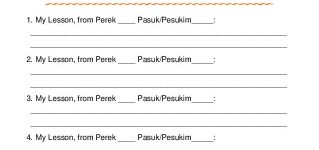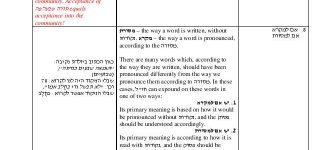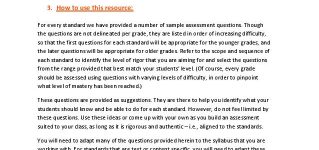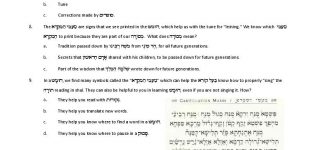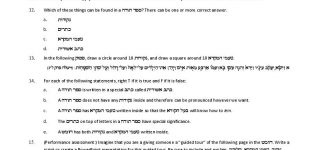תנ”ך Conventions
The student will be able to use the conventions of תנ”ך, such as its method of punctuation and the way it is organized, as the guide to being able to read the text with better understanding.
Note to Teachers:
- The Conventions Appendix is referenced throughout this standard, with the number for each particular convention.
- The scope and sequence for this standard is suggested, but if a particular convention comes up in the חומש earlier, it can be taught then.
- Conventions which appear in the Appendix but are not scoped below should be taught when they come up in the חומש.
| Enduring Understandings |
|---|
| 1. Chumash conventions are part of the מסורה from סיני and preserve its integrity. |
| 2. The חומש conventions are precise and significant, and the basis for many important לימודים. |
| Essential Questions |
|---|
| 1. Why is it hard to learn from a ספר תורה? Do we need punctuation? Where do all the symbols and markings in חומש that I don’t see in the ספר תורה come from? |
| 2. Why is the חומש text so “busy”? Why are there so many dots, symbols and confusing letters in the חומש? |
לשון התורה 1.03
B. N/A
C. N/A
B. Recognize that the Torah speaks ‘בלשון נקי and will often use more words to say something in a nicer way e.g איננו טהור instead of טמא.
C. Recognize that דברה תורה בלשון בני אדם – the Torah is written in a way that Man can understand, but it not literal when speaking about Hashem. E.g.. Hashem has no Hand. (This is anthropomorphic language.)
B. Recognize that the Torah speaks ‘בלשון נקי and will often use more words to say something in a nicer way e.g איננו טהור instead of טמא.
C. Recognize that דברה תורה בלשון בני אדם – the Torah is written in a way that Man can understand, but it not literal when speaking about Hashem. E.g.. Hashem has no Hand. (This is anthropomorphic language.)
B. Recognize that the Torah speaks ‘בלשון נקי and will often use more words to say something in a nicer way e.g איננו טהור instead of טמא.
C. Recognize that דברה תורה בלשון בני אדם – the Torah is written in a way that Man can understand, but it not literal when speaking about Hashem. E.g.. Hashem has no Hand. (This is anthropomorphic language.)
B. Knows that ‘לשון נקי is one example of תיקון סופרים, changes in the way that something is written in the תורה in order to teach us something, and can name some other examples as well.
C. Recognize that דברה תורה בלשון בני אדם – the Torah is written in a way that Man can understand, but it not literal when speaking about Hashem. E.g.. Hashem has no Hand. (This is anthropomorphic language.)
B. Knows that ‘לשון נקי is one example of תיקון סופרים, changes in the way that something is written in the תורה in order to teach us something, and can name some other examples as well.
C. Recognize that דברה תורה בלשון בני אדם – the Torah is written in a way that Man can understand, but it not literal when speaking about Hashem. E.g.. Hashem has no Hand. (This is anthropomorphic language.)
B. Knows that ‘לשון נקי is one example of תיקון סופרים, changes in the way that something is written in the תורה in order to teach us something, and can name some other examples as well.
C. Recognize that דברה תורה בלשון בני אדם – the Torah is written in a way that Man can understand, but it not literal when speaking about Hashem. E.g.. Hashem has no Hand. (This is anthropomorphic language.)
B. Knows that ‘לשון נקי is one example of תיקון סופרים, changes in the way that something is written in the תורה in order to teach us something, and can name some other examples as well.
C. Recognize that דברה תורה בלשון בני אדם – the Torah is written in a way that Man can understand, but it not literal when speaking about Hashem. E.g.. Hashem has no Hand. (This is anthropomorphic language.)
Grades 2-4: Recognize that the Torah speaks ‘בלשון נקי and will often use more words to say something in a nicer way e.g איננו טהור instead of טמא.
Grades 5-8: Knows that ‘לשון נקי is one example of תיקון סופרים, changes in the way that something is written in the תורה in order to teach us something, and can name some other examples as well.
Grade 2-8:Recognize that דברה תורה בלשון בני אדם – the Torah is written in a way that Man can understand, but it not literal when speaking about Hashem. E.g.. Hashem has no Hand. (This is anthropomorphic language.)
[6] אותיות רבתי–זעירי, נ הפוכה, ניקוד מעל האותיות, אותיות תלויות, כתרים (See items 9, 10 and 11 in Appendix).
Resources
1.04 כתב, אותיות וניקוד
B. Recognizes that although there are no נקודות under the words in the ספר תורה, (as it is indicated by the נקודות in חומש) they are still part of the מסורה (Appendix #4)
C. Recognize that at times the same words can be written differently in the Torah, with or without the (אמות הקריאה (אהוי and this is called מלא כתיב or חסר כתיב and lessons can be learnt from these variations.
D. N/A
B. Recognizes that although there are no נקודות under the words in the ספר תורה, (as it is indicated by the נקודות in חומש) they are still part of the מסורה (Appendix #4)
C. Recognize that at times the same words can be written differently in the Torah, with or without the (אמות הקריאה (אהוי and this is called מלא כתיב or חסר כתיב and lessons can be learnt from these variations.
D. N/A
C. Recognize that at times the same words can be written differently in the Torah, with or without the (אמות הקריאה (אהוי and this is called מלא כתיב or חסר כתיב and lessons can be learnt from these variations.
D. Recognizes that there are times when the a word is written one way (כתיב)but we are meant to pronounce it another way (קרי)and this is called קרי וכתיב and is part of מסורה.
C. Recognize that at times the same words can be written differently in the Torah, with or without the (אמות הקריאה (אהוי and this is called מלא כתיב or חסר כתיב and lessons can be learnt from these variations.
D. Recognizes that there are times when the a word is written one way (כתיב)but we are meant to pronounce it another way (קרי)and this is called קרי וכתיב and is part of מסורה.
C. Recognize that at times the same words can be written differently in the Torah, with or without the (אמות הקריאה (אהוי and this is called מלא כתיב or חסר כתיב and lessons can be learnt from these variations.
D. Recognizes that the קרי וכתיב which is part of מסורה hints to varying messages and can begin to suggest the differences in the meanings of the קרי וכתיב in learned פסוקים.
C. Recognize that at times the same words can be written differently in the Torah, with or without the (אמות הקריאה (אהוי and this is called מלא כתיב or חסר כתיב and lessons can be learnt from these variations.
D. Recognizes that the קרי וכתיב which is part of מסורה hints to varying messages and can begin to suggest the differences in the meanings of the קרי וכתיב in learned פסוקים.
C. Recognize that at times the same words can be written differently in the Torah, with or without the (אמות הקריאה (אהוי and this is called מלא כתיב or חסר כתיב and lessons can be learnt from these variations.
D. Recognizes that the קרי וכתיב which is part of מסורה hints to varying messages and can begin to suggest the differences in the meanings of the קרי וכתיב in unlearned פסוקים.
C. Recognize that at times the same words can be written differently in the Torah, with or without the (אמות הקריאה (אהוי and this is called מלא כתיב or חסר כתיב and lessons can be learnt from these variations.
D. Recognizes that the קרי וכתיב which is part of מסורה hints to varying messages and can begin to suggest the differences in the meanings of the קרי וכתיב in unlearned פסוקים.
Grades 3-8: Identifies that כתב אשורית is the unique script that is only used for סת”ם, and that there are unique features connected to the כתב in a ספר תורה that have significance.[6]
Grades 3-4: Recognizes that there are times when the a word is written one way (כתיב)but we are meant to pronounce it another way (קרי)and this is called קרי וכתיב and is part of מסורה.
Grades 5-6: Recognizes that the קרי וכתיב which is part of מסורה hints to varying messages and can begin to suggest the differences in the meanings of the קרי וכתיב in learned פסוקים.
Grades 7-8: Recognizes that the קרי וכתיב which is part of מסורה hints to varying messages and can begin to suggest the differences in the meanings of the קרי וכתיב in unlearned פסוקים.
[6] אותיות רבתי–זעירי, נ הפוכה, ניקוד מעל האותיות, אותיות תלויות, כתרים (See items 9, 10 and 11 in Appendix).
Resources
1.05 טעמי המקרא
Grades 3-8: Recognizes that although there is no punctuation in a ספר תורה, the טעמי המקרא that we see in the חומש, which indicate the punctuation, pronunciation (הברה) and the tune, are part of the מסורה.i(#5 in Appendix)
Resources
1.06 חלוקה לפרשיות, פרקים
B. N/A
B. N/A
B. Distinguishes between a פרשה פתוחה and פרשה סתומה and understands their function. (#2 in Appendix)
B. Distinguishes between a פרשה פתוחה and פרשה סתומה and understands their function. (#2 in Appendix)
B. Uses the division of פרשיות פתוחות and סתומות to divide the text into ענינים (rather than only using פרקים for topic division). (#2 in Appendix)
B. Uses the division of פרשיות פתוחות and סתומות to divide the text into ענינים (rather than only using פרקים for topic division). (#2 in Appendix)
B. Uses the division of פרשיות פתוחות and סתומות to divide the text into ענינים (rather than only using פרקים for topic division). (#2 in Appendix)
B. Uses the division of פרשיות פתוחות and סתומות to divide the text into ענינים (rather than only using פרקים for topic division). (#2 in Appendix)
Grades 3-8: Knows that the סדרות are from חז”ל but the פרקים come from when the Torah was translated and is not from Jewish sources.
Grades 3-4: Distinguishes between a פרשה פתוחה and פרשה סתומה and understands their function. (#2 in Appendix)
Grades 5-8: Uses the division of פרשיות פתוחות and סתומות to divide the text into ענינים (rather than only using פרקים for topic division). (#2 in Appendix)

